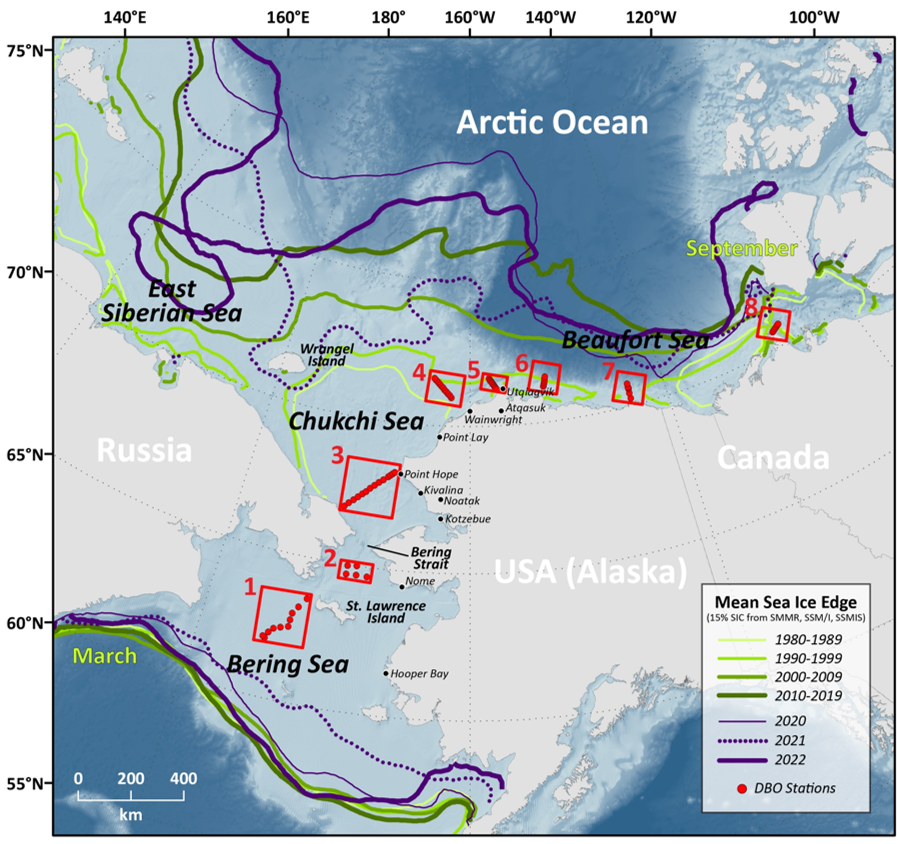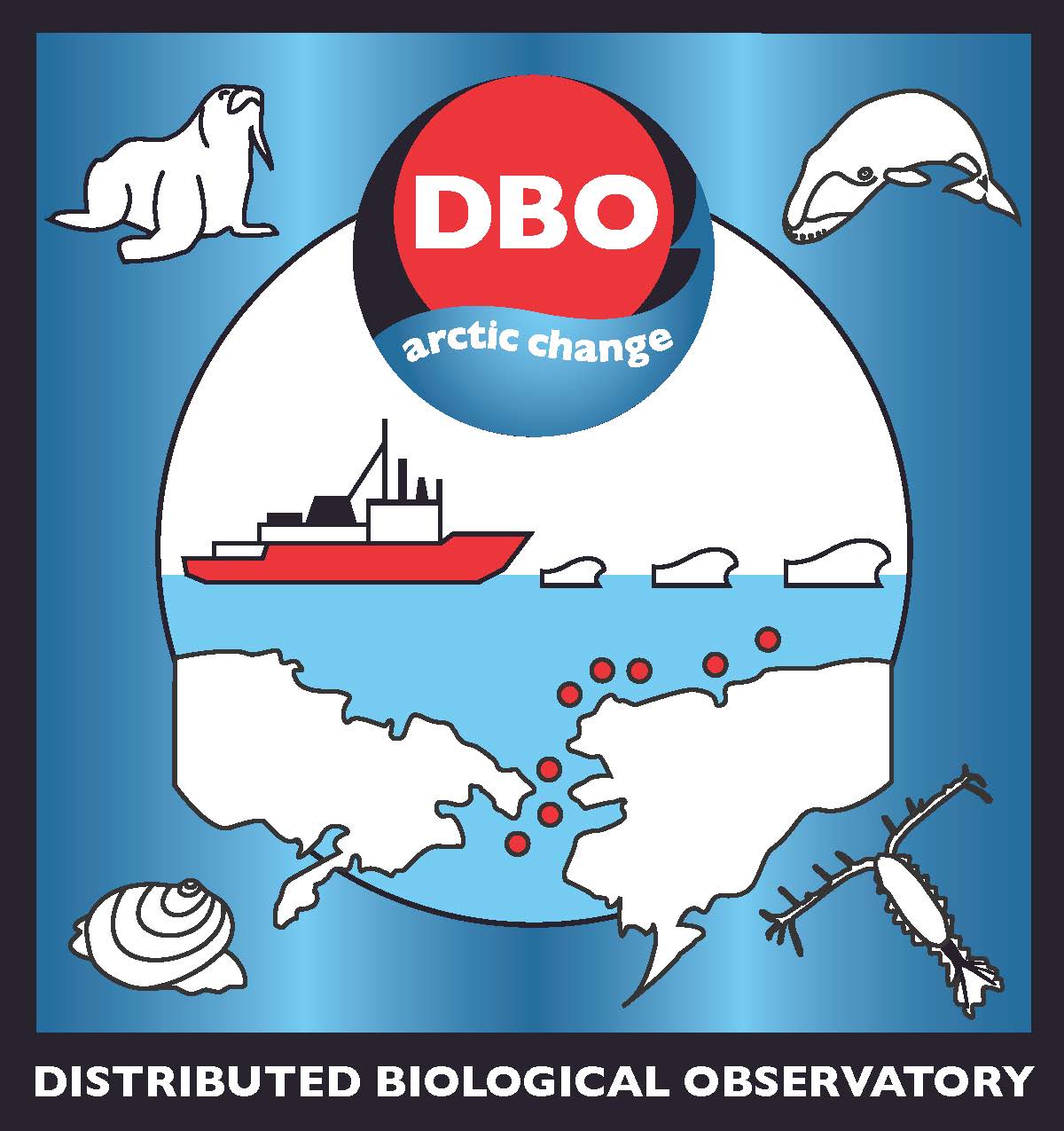About The Distributed Biological Observatory
The overarching goal of the Distributed Biological Observatory (DBO) collaboration team that is funded through the US National Science Foundation (NSF) and the US National Oceanic and Atmospheric Administration (NOAA) is full-implementation of standardized ocean sampling in five regions of high productivity and biodiversity that extend from the northern Bering Sea to the Chukchi and Beaufort Seas. Other countries that are currently participating in this research framework in the Pacific Arctic through separate national funding include Canada, Japan, the Republic of Korea and China. The pilot international DBO program in the Pacific Arctic was begun in 2010 and demonstrated the utility of the DBO sampling protocol, where each country sending research vessels through the Bering Strait region would coordinate sampling and share research results. The DBO sampling concept is currently being expanded to other portions of the Arctic, including the Canadian Beaufort Sea, Baffin Bay, in waters near Svalbard, and possibly in the Laptev Sea through German-Russian cooperative programs. Annual review of DBO data is facilitated through the international Pacific Arctic Group, including data sharing forums and sharing of cruise plans at annual meetings of the PAG. Through development of a broad scale ocean observatory, the DBO team aims to provide a long-term biologically-focused scientific foundation to understand how the ecosystem of the Pacific Arctic is changing as water temperatures warm, sea ice declines, and the biological system adjusts to the "new" Arctic. We also expect these data should improve the ability of resource management and mission-oriented agencies (e.g., US Bureau of Ocean Energy Management and US National Oceanographic and Atmospheric Administration) to fine-tune or adjust actions that impact marine resources, local communities, and biological systems. Ultimately, this research therefore contributes to improved conservation, protection, and management of Arctic coastal and ocean resources.
Introduction and History of US and international program

The DBO development effort picked up momentum in the USA when several U.S. agencies endorsed the DBO concept in Arctic research planning documents, and it was incorporated into the coordinated Arctic research efforts of the the U.S. Interagency Arctic Research Policy Committee (IARPC), which is comprised of representatives from the 13 US federal agencies with interests in the outcomes of Arctic research. On an international level, the Marine Working Group of the International Arctic Science Committee (IASC) endorsed the DBO, including expansion to the Atlantic sector of the Arctic, and has provided support for early career scientists to attend DBO data workshops several times.
Understanding the impacts of reduced seasonal sea ice and a warming water column on benthic processes are essential to track and forecast ecosystem response in the Pacific Arctic region. Within our research program NOAA supports the Distributed Biological Observatory-Northern Chukchi Integrated Study (DBO-NCIS) for sample collections in the northern Bering and Chukchi Seas of several key water column parameters, phytoplankton species composition, sediment parameters, whole core metabolism measurements, and benthic macrofaunal composition and biomass. Our project goals are to determine hydrographic and sediment characteristics that influence macrofaunal communities and ecosystem function through field and synthesis activities. Our project collaborates with other disciplinary investigators as part of NOAA's Ecosystems & Fisheries Oceanography Coordinated Investigations (EcoFOCI), the Arctic Marine Biodiversity Observing Network (AMBON), and the Chukchi Ecosystem Observatory (CEO). The coordinated research is continuing ongoing time series efforts that are evaluating key processes influencing the status and trends in the Pacific Arctic ecosystem. The annual field cruise also includes sediment and benthic macrofaunal samples collected for investigating harmful algal bloom trophic impacts being undertaken by NOAA-investigators as part of the Alaska Harmful Algal Bloom (HAB) network that is an important issue of food security in the region. NOAA is also supporting the DBO sampling concept with multiple cruises undertaken from the USCGC Healy (2017-2019), the NOAA vessel Oscar Dyson and Norseman II in 2020, and the RV Sikuliaq in 2021 and 2023. These are typically longer cruises that allow for process type experiments such as incubation experiments to assess, for example how changing water temperatures are affecting organisms, as well as recovery and deployment of moored instruments that provide year-long coverage of conditions in the northern Bering and Chukchi seas. Both US academic and NOAA scientists are participating in these research efforts. Click here to visit the new NOAA-DBO landing page.
Selected Projects and US and International Agencies That Have Incorporated DBO Sampling
A number of research projects and institutions have incorporated DBO sampling as part of larger observational efforts in the greater Bering Strait region. This data portal provides access and links to data collected from the following projects or institutions:
- Alaska Monitoring and Assessment Program (AKMAP)
- Arctic Ecosystem Integrated Survey (EIS)
- Arctic Marine Biodiversity Observing Network (AMBON)
- Arctic Observing Network (AON)
- Bering Arctic-Subarctic Integrated Survey (BASIS)
- Bowhead Whale Feeding Ecology Study (BOWFEST)
- Canada's Three Oceans (C3O)
- Chinese National Arctic Research Expedition (CHINARE)
- Chukchi Sea Environmental Studies Program (CSESP)
- Chukchi Sea Offshore Monitoring in Drilling Area (COMIDA)
- Impacts of Climate on the Eco-Systems and Chemistry of the Arctic Pacific Environment (ICESCAPE)
- NASA Goddard Space Flight Center (NASA)
- Russian-American Long-term Census of the Arctic (RUSALCA)
Forward Planning and Accomplishments
Regionally, the DBO Implementation Plan identifies specific strategies to foster connections with existing community-based observation programs in an effort to link offshore observations of biological change to local observations and Indigenous knowledge. Internationally, linkages to pan-Arctic DBO-type sampling programs will be fostered, including transects identified by the Arctic Council Conservation of Arctic Flora and Fauna (CAFF)/Circumpolar Biodiversity Monitoring Program (CBMP) and the Protection of the Arctic Marine Environment (PAME)/Implementation of Ecosystem Approach (EA) to Management Program.
The completion of the DBO Implementation Plan was a specific DBO collaboration team milestone in the 2013-2017 IARPC Plan and was publicly vetted at the 3rd DBO Data Workshop, the 2016 Arctic Observing Summit, and the PAME EA International Conference, as well as at various other national and international venues. Other significant achievements include the completion of year-7 of sampling in DBO/Chukchi regions 1-5, and opportunistic sampling in DBO/Beaufort regions 6-8. Field-sampling data was contributed by colleagues from 11 projects representing 5 countries.
In 2019, a first special issue of the academic journal Deep-Sea Research Part II: Topical Studies in Oceanography, volume 62 featured a series of results from the initial program; other special issues are planned and results have also been published in other peer-reviewed journals.
Distributed Biological Observatory 10 year implementation plan
